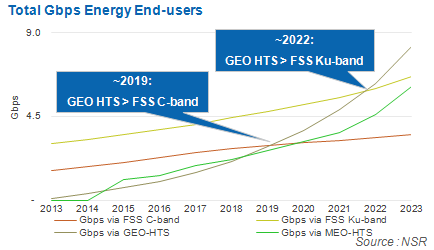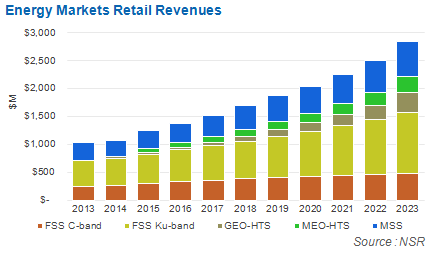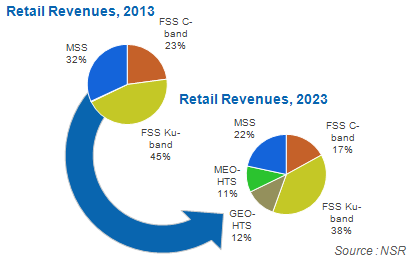|
|
HTS in Energy Markets: A Zero-Sum Game?
Aug 13th, 2014 by Brad
Grady, NSR
As more High Throughput Satellites (HTS) launch,
arrive in orbit and become operational in the next 12 to 18
months, many in the industry are asking, “How will HTS affect
[insert market here]?” For consumer markets in North
America, and Europe to a lesser extent, HTS can and does have a
role to play in consumer broadband access. For
“Enterprise” applications, there is definitely a role for HTS.
And, for Mobility. And, for…But will this mean it’s a
zero-sum game between FSS and HTS players?
In Energy markets – Oil & Gas, Mining, and
Electrical Utilities – HTS will not in-itself be a ‘revolution,’
but rather a continuation of what fixed satellite service (FSS)
providers know and are already providing: CIR-based
offerings with strong SLAs. HTS will be add fuel
on the capacity fire but that fire was already started before
due to real-time video monitoring reaching everywhere and
anywhere, business operations becoming more sophisticated, and
crew services a key service. Combined, all these applications
were already driving demand in this market..
As NSR found in its
Energy Markets via Satellite, 4th Edition,
HTS-based services will not be a ‘year-zero’ adoption, but
rather a steadily growing opportunity as end-users become more
familiar with the technology. End-users continue to care
more about making their network work than adopting the latest
and greatest technology… or even price for some sub-markets
within the energy vertical.

FSS users in C- and Ku-bands will continue to
require more Gbps to end-users through 2019, the year of the
inflection point between GEO-HTS and FSS C-band…but not the
death knell for FSS C-band. Instead, it is where end-users
and service providers will see the uptake of GEO-HTS services
surpass a flattening demand for FSS C-band. 2022 will be
another key point in the curve, where GEO-HTS uptake in terms of
Gbps of demand from end-users will surpass FSS Ku-band.
Put another way – by 2023 more than 50% of total
capacity demand in Gbps from Energy End-users on VSAT networks
will be delivered by HTS-based services (both in GEO
and MEO orbits.)
For MEO-HTS, the story is fairly simple – lower
latency and higher throughputs are an appealing value
proposition, but it all comes down to three things as in real
estate: location, location, and location. End-users
located in the sweet-spot of announced coverage for MEO-HTS
offerings (+/- 45 Degrees) AND with enough real estate for a
couple of 1.2M+ VSATs AND with significant capacity demands will
find MEO-HTS offerings an appealing service. Those more
mobile or those with less space or those with lower capacity
demand will face a less attractive cost-benefit analysis.
One thing is clear though for MEO-HTS offerings, ignoring all
other aspects: lower latency definitely has a place.
GEO-HTS is another story. With different
frequencies, technologies, “Open vs. Closed” ecosystems, etc. it
is harder to pick specific ‘winners and losers.’ However,
at a macro-level HTS will be a key enabler for delivering and
powering the on-going digitization of and connected-devices in
the Energy markets. Each GEO-HTS offering will have a role
to play within the energy market – enabling ‘office’
connectivity at remote locations, or global mobility, or
backwards capability. One thing is clear amongst all of
the GEO-HTS offerings, a focus on CIR-based services with high
SLAs will be key to getting energy end-users to adopt the
technology. And, only time will allow the ‘proof’ that
most sub-markets within the energy industry require to be made.

So, with the promise of lower cost per bit, and/or
lower latency from HTS-centric offerings… what does FSS continue
to bring to the table? Within the emerging ‘middle
bandwidth’ markets for SCADA + video monitoring sites (such as
pipeline compressor stations, or utility sub-stations) the
advantage of lower prices is relatively moot. As equipment
and services comprises a larger share of the pie relative to
straight capacity expenditures, and a lengthy process to get
technology certified to operate either with grid operators or in
hazardous conditions there remains plenty of life left for FSS
in these volume-based markets.

In higher bandwidth markets such as Offshore E&P,
reliability and availability is paramount. Meaning,
end-users will continue to leverage FSS C-band offerings in
areas with higher incidents of rain-fade… rather than risk
downtime. For these end-users, it will not be an either or
solution, but rather a hybrid approach to maximize throughput
AND availability, while managing costs at the same time.
Bottom Line
With over three-quarters of capacity demand coming
from the Oil & Gas Exploration and Production over the next ten
years in the Energy markets, the satellite industry will need to
keep looking at advances in real-time drilling, sub-sea
technologies, and crew welfare trends to continue to match the
right technology to the right problem. GEO-HTS or MEO-HTS
is not the “everything, everywhere, everyone” solution for
Energy markets. FSS C-band and FSS Ku-band will continue
to have their place in the “HTS era,” but it is not a zero-sum
game.
|
 |